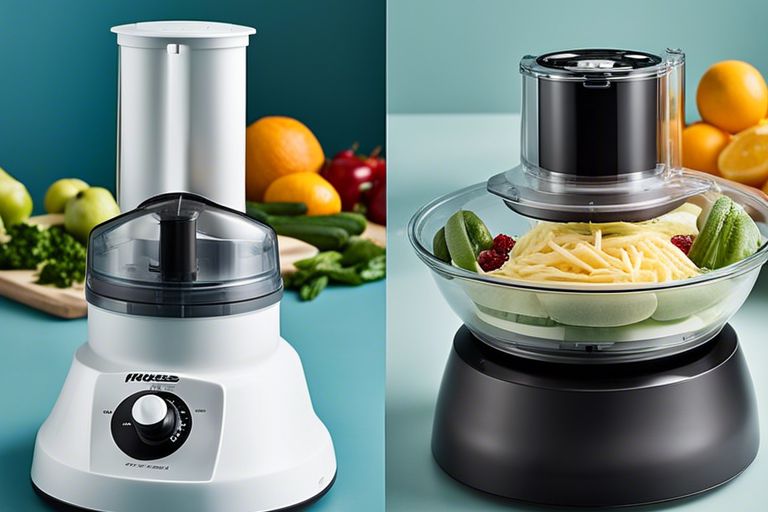Finding the Right Food Processor for Chopping, Slicing, and More
There’s a multitude of options available when it comes to choosing the perfect food processor for your kitchen needs. From chopping and slicing to pureeing and blending, finding the right one can make meal prep a breeze. By considering factors like capacity, power, and additional features, you can select a food processor that suits your cooking style and simplifies your time in the kitchen. Let’s explore the key factors to keep in mind when searching for the ideal food processor to elevate your culinary creations.

Contents
Factors to Consider When Choosing a Food Processor
The right food processor can make a world of a difference in your kitchen. To ensure you select the most suitable one for your needs, consider the following factors:
- Functionality for Chopping, Slicing, and More
- Size and Capacity
- Power and Speed
Functionality for Chopping, Slicing, and More
With a food processor, you want to look for a machine that offers various functions such as chopping, slicing, grating, and kneading. This versatility will allow you to prepare a wide range of dishes with ease.
Size and Capacity
With size and capacity, consider how much food you typically process. If you cook for a large family or like to meal prep, a larger capacity processor might be more suitable. However, if you have limited storage space or only cook for one or two people, a smaller processor may suffice.
Another important aspect to consider is the size of the feeding tube. A larger feeding tube allows you to process larger pieces of food without having to pre-cut them, saving you time and effort in the kitchen.
Power and Speed
More power and higher speeds often mean faster and more efficient processing. Look for a food processor with a powerful motor to handle tough ingredients such as nuts or hard cheeses. Additionally, multiple speed settings can provide you with greater control over the consistency of your ingredients.
Choosing a food processor that meets your specific needs in terms of functionality, size, capacity, power, and speed will ensure that you can make the most out of this versatile kitchen appliance.
Types of Food Processors Available
One important factor to consider when choosing a food processor is the type that best suits your needs. Here are the main types of food processors available:
| Mini Food Processors | Smaller in size, ideal for everyday chopping, grinding, and small batch processing. |
| Full-Size Food Processors | Larger capacity for more extensive food preparation tasks such as slicing, grating, and kneading. |
| Food Processor Attachments | Additional accessories that expand the functionality of your food processor for various food processing tasks. |
Mini Food Processors
For quick and efficient chopping and grinding tasks, mini food processors are the perfect choice. They are compact, making them easy to store and convenient for everyday use in a smaller kitchen or for preparing small quantities of ingredients.
Full-Size Food Processors
Available in larger sizes with more powerful motors, full-size food processors are designed to handle more extensive food preparation tasks. They can slice, shred, knead dough, and perform other functions with ease, making them a versatile addition to any kitchen.
Food Processor Attachments
An array of attachments such as slicing discs, shredding blades, and dough hooks can be used with food processors to enhance their capabilities. These attachments allow you to customize the functions of your food processor to suit different recipes and cooking styles.
Tips for Maintenance and Care of Your Food Processor
All food processors require proper maintenance to ensure longevity and optimal performance. Here are some important tips to keep your appliance in top shape:
- Regularly clean all parts of the food processor after each use.
- Make sure the appliance is completely dry before storing to prevent mold or bacterial growth.
- Handle blades and other sharp components with care to avoid injuries.
Though these tasks may seem minor, they are crucial in maintaining the efficiency and safety of your food processor.
Cleaning and Storing
Food particles can build up in the nooks and crannies of your food processor, leading to bacterial growth. After each use, disassemble the parts and wash them thoroughly with warm, soapy water. Allow all components to dry completely before reassembling and storing the appliance in a clean, dry place.
Blade Sharpening and Replacement
Food processor blades can become dull over time, affecting the quality of the cuts and slices. Regular blade sharpening or replacement is important to maintain the efficiency of your appliance. Some manufacturers offer replacement blades for purchase, or you can opt for professional sharpening services to ensure precision cutting.
Maintenance
To keep your food processor running smoothly, it’s crucial to follow the manufacturer’s guidelines for blade sharpening and replacement. Regular maintenance will not only extend the life of your appliance but also ensure safe and efficient food preparation. Always handle sharp blades with care and store them properly to prevent accidents.
Final Words
With these considerations in mind, choosing the right food processor for chopping, slicing, and more becomes a simple task. By assessing your needs, considering the size and power you require, and looking into the additional features available, you can find a food processor that will make your meal preparation a breeze. Invest in a high-quality appliance that suits your cooking habits and enjoy the efficiency and convenience it brings to your kitchen.



